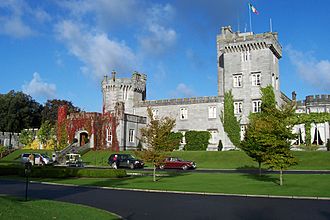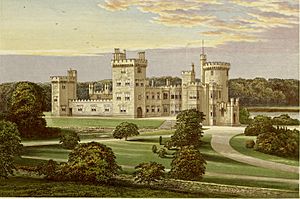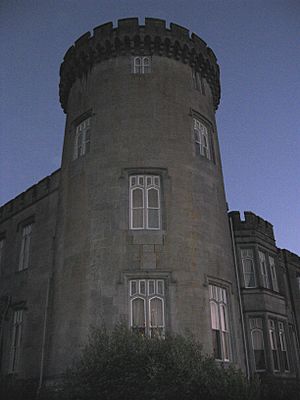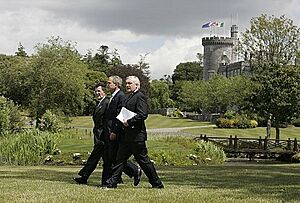Dromoland Castle facts for kids
Quick facts for kids Dromoland Castle |
|
|---|---|

Entrance to Dromoland Castle
|
|
| General information | |
| Status | Luxury hotel |
| Type | castle |
| Architectural style | Gothic Revival |
| Location | County Clare |
| Country | Ireland |
| Estimated completion | 15th/16th century (original) 1835 (current structure) |
| Design and construction | |
| Architect | James and George Richard Pain (current structure) |
| Dromoland Castle | |
|---|---|
| Restaurant information | |
| Head chef | Jean Baptiste Molinari |
| Rating | |
| City | Newmarket-on-Fergus |
| Country | Ireland |
Dromoland Castle (which means "Hill of Litigation" in Irish) is a beautiful castle located near Newmarket-on-Fergus in County Clare, Ireland. Today, it is a fancy 5-star luxury hotel with its own golf course. Its restaurant, called Earl of Thomond, even earned a special award, a Michelin star, in 1995.
The castle you see today was finished in 1835. However, the very first building on this spot was a tower house built a long time ago, in the 1400s or early 1500s. Over the years, there were at least three different houses called Dromoland on this land. For many generations, Dromoland was the home of the O'Brien family.
Contents
A Look Back at Dromoland's Past
Early Days of Dromoland Castle
In 1551, a man named Murrough O'Brien owned Dromoland. He was given the title of the first Earl of Thomond by King Henry VIII. Murrough passed Dromoland Castle to his son, Donough MacMurrough O'Brien.
Later, in 1582, Donough was accused of rebellion and his property was taken by the government. However, the O'Brien family tried to get Dromoland back.
The O'Brien Family's Long Connection
In 1604, Conor O'Brien passed away, leaving Dromoland to his young son, Donough MacConor O'Brien. There was a legal disagreement over who truly owned the castle. Eventually, in 1613, it was decided that the Earl of Thomond would own Dromoland.
However, Donough later disagreed with this decision. Despite this, Dromoland remained with the Earls of Thomond for about 50 more years.
Changes and New Owners
During a rebellion in 1641, a man named Robert Starkey was living at Dromoland. Later, in 1642, Colonel Conor O'Brien took control of the castle. Conor was killed in battle in 1651. His son, Donough O'Brien, inherited the family's claim to Dromoland.
In 1684, Donough O'Brien finally became the full owner of Dromoland. At this time, it was a simple house. The original tower house had been added to before Donough moved in.
Expanding the Castle
Sir Donough O'Brien, the 1st Baronet, passed away in 1717. During his time, Dromoland was described as a "handsome Grecian Building." His grandson, Edward, became the 2nd Baronet. Edward decorated the house with art. He also had plans drawn up for a new, bigger house.
John Aheron was likely the architect who designed the new building. He also designed the interesting Gazebo on Turret Hill, which is across the road from the castle's main entrance. This gazebo was probably used to watch horse training. Dromoland grew into a large, two-and-a-half-story house. A two-story square courtyard was finished in 1736.
The Grand Rebuilding
In 1795, a magazine described Dromoland as a "noble and beautiful seat" with lovely views of the rivers Fergus and Shannon.
Sir Lucius O'Brien was the 3rd Baronet. After he died in 1794, his son, the second Sir Edward, became the 4th Baronet. Edward decided to rebuild the castle completely. Work started around 1822 and cost a lot of money.
Edward O'Brien chose a neo-gothic style for the new castle. This style was popular at the time and looked like old medieval castles. The architects were James and George Richard Pain, who had learned from a famous architect named John Nash. The amazing building you see today was finished in 1835.
In 1837, a writer named Samuel Lewis called Dromoland "a superb edifice in the castellated style". He noted it was surrounded by beautiful, wooded land. Edward's wife, Charlotte Smith, had inherited wealth, which likely helped pay for the castle's construction.
Dromoland Today
Dromoland Castle has stayed mostly the same since the mid-1800s. The mansion has a "baronial" or "Gothic Revival" look. It has four connected towers that look like castle turrets. A gothic porch at the front shows the O'Brien family's coat of arms.
The castle faces a lake on one side and a hill on the other. To the south, there are large walled gardens. In 1902, an old 17th-century gateway was moved from another castle and placed at the entrance to these gardens. A long, winding driveway leads from the main entrance to the castle's front door.
In 1962, Donough O'Brien, the 16th Baron Inchiquin, sold Dromoland Castle and its land because of money problems. He then built a new house nearby called Thomond House.
Dromoland as a Hotel
Dromoland Castle was bought by an American citizen, Bernard P. McDonough, in 1962. Since then, it has been turned into a very fancy, top-quality luxury hotel.
Dromoland Castle Hotel is also part of a group called Historic Hotels Worldwide, which means it's recognized for its important history.
Famous Visitors
Many important people have stayed at Dromoland Castle. In 2004, United States President George W. Bush stayed there for a summit meeting. About 7,000 police and security forces protected him during his visit.
Other famous guests who have visited Dromoland Castle include:
- Bill Clinton (another former US President)
- Juan Carlos I of Spain (former King of Spain)
- Nelson Mandela (famous anti-apartheid revolutionary and former President of South Africa)
- Muhammad Ali (legendary boxer)
- Richard Branson (famous businessman)
- Jack Nicholson (actor)
- Johnny Cash (singer)
- Michael Flatley (dancer)
- Bono (singer from U2)
- John Travolta (actor)
Images for kids





